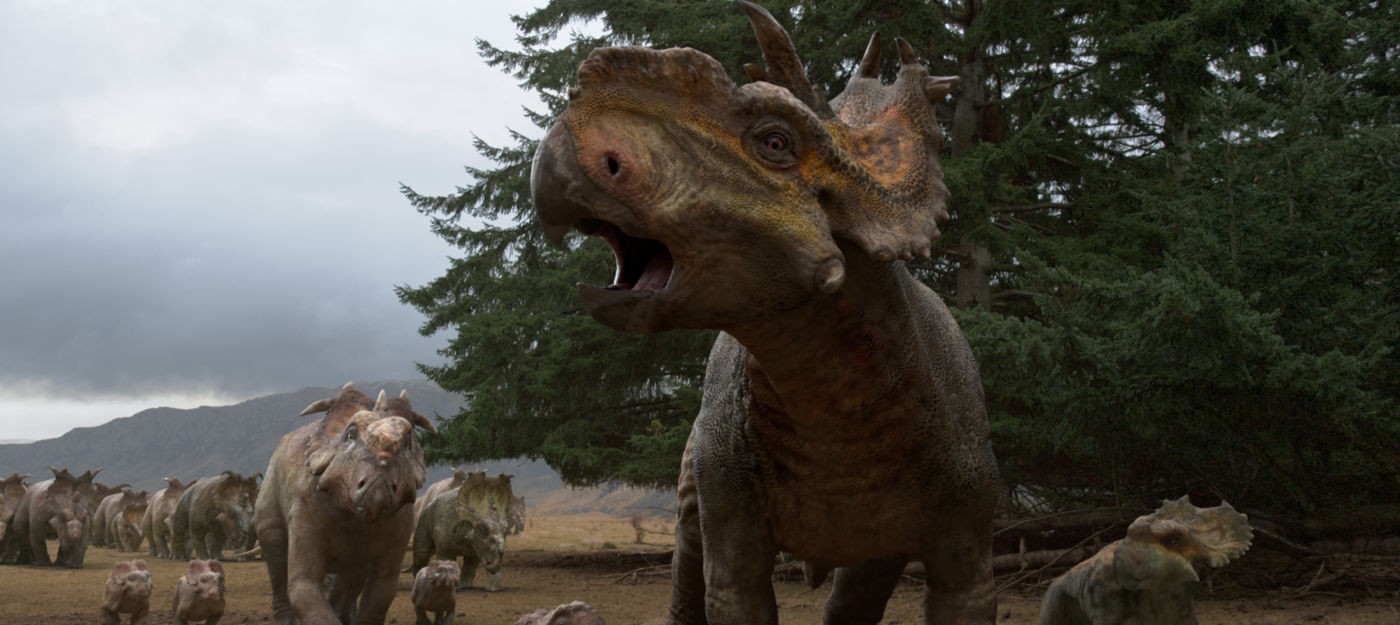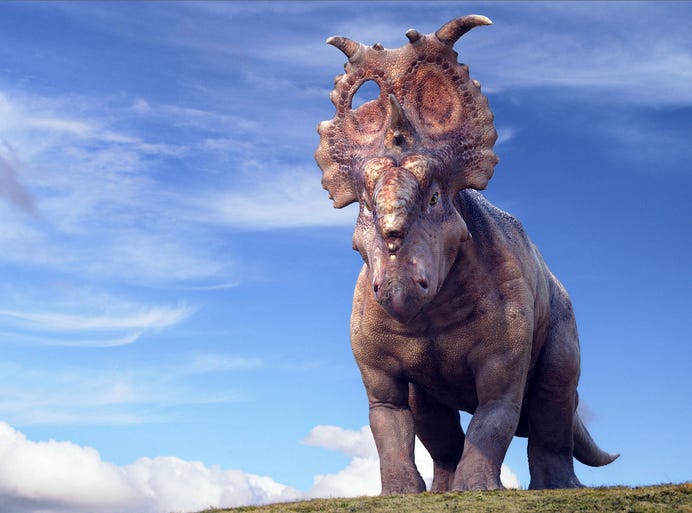11 Things You Thought You Knew About Creatures That Once Roamed Planet Earth
It's kind of hard to believe that gigantic dinosaurs - that no human has ever come in contact with - once roamed planet Earth planet.
1. Dinosaurs Lived In Alaska 70 Million Years Ago During The Late Cretaceous
"I've seen dinosaur footprints in Alaska now in rocks from southwest Alaska, the North Slope and Denali National Park in the Interior, but there aren't many places where footprints occur in such abundance," said expedition researcher Paul McCarthy of the University of Alaska Fairbanks.
An illustration of dinosaurs, as seen in the film "Walking With Dinosaurs".
Image via deviantart.netResearchers may have just scratched the surface of a major new dinosaur site nearly inside the Arctic Circle. This past summer, July 2013, they discovered thousands of fossilized dinosaur footprints, large and small, along the rocky banks of Alaska's Yukon River.
2. In The Past 15 Years, Dinosaur Remains Have Been Established From Every Continent
Scientists excavate a 43-foot-long (13-meter-long) skeleton of a new species of sauropod - or four-legged plant-eater - in an undated photo released during the week of 15 September 2009 in the Agadez Region, Niger.
Image via nationalgeographic.comScientists clean up the fossil of a dinosaur excavated in Liudian township in Ruyang County, central China's Henan Province, Dec. 9, 2008.
Image via sina.comOn scenic Lake Shore Drive in the Chicago’s Museum Campus, the Field contains the most complete Tyrannosaurus skeleton in the world.
Image via ratestogo.comIn this undated image released by Mexico’s National Anthropology and History Institute (INAH) on Monday, July 22, 2013, the tail of a dinosaur is uncovered at a paleontological dig site near the town of General Cepeda in northern Mexico.
Image via theblaze.com3. Bone Growth Variations In Some Polar Herbivorous Dinosaurs Suggest That They May Have Been Able To Feed All Year Round
Anthony Fiorillo, a paleontologist at the Museum of Nature and Science, hypothesised that the microscopic structures of the Cretaceous Period fossils could show how they lived in polar regions.
“The bone microstructure of these dinosaurs is actually a record of how these animals were growing throughout their lives, it is almost similar to looking at tree rings," said a professor of zoology at the University of Cape Town.
“What we found was that periodically, throughout their life, these dinosaurs were switching how fast they were growing, we interpreted this as potentially a seasonal pattern because we know in modern animals these types of shifts can be induced by changes in nutrition. But that shift is often driven by changes in seasonality.”
4. 'Bone Beds' Are Huge Areas Where The Remains Of Hundreds Of Animals, Old And Young, Are Jumbled Together
Disarticulated dinosaur bones in steeply tilted, fluvial, fossiliferous conglomeratic sandstone - Morrison Formation.
Image via osu.edu5. Evidence Suggests That Bone Beds Occurred Because Of A Mass Death
Mass accumulations of fossilised large terrestrial vertebrate skeletons (bone beds:BB) provide a test for K-T catastrophic extinction hypotheses. Catastrophic mass mortality (CMM) is the "sudden" death of numerous individuals where species, age, health, gender, social ranking, etc., offer no survivorship advantage.
harvard.edu6. T-Rex Had A Close Relative, Gorgosaurus, Who Was A Little Faster And More Agile That Lived Earlier
orgosaurus could grow a massive 50kg (110lb) each year before it reached sexual maturity. That's almost the weight of a person each year.
Image via walkingwithdinosaurs.comGorgosaurus teeth were banana shaped but serrated like a carving knife - perfect for sawing into flesh. A keen sense of smell was important in tyrannosaurids. Their olfactory bulbs are large. Gorgosaurus would have been excellent at locating food over large territories.
7. Some Azhdarchid Pterosaurs Had Wingspans The Size Of Fighter Planes
Azhdarchids predominantly inhabited inland areas. Montanazhdarkho lived in the seasonal, semi-arid environment of North America, and one of the largest azhdarchids of all, Quetzalcoatlus, lived inland, around lakes and rivers on semi-arid plains.
Image via walkingwithdinosaurs.comAzhdarchids had exceptionally long, straight beak-like jaws which have been conservatively estimated at over 2.5m (8ft) in some species.
8. Foot Impressions Suggest That Protoceratops Would Stop And Have A Rest Together While They Were On The Move
An illustration of Protoceratops, as seen in a "Walking With Dinosaurs" movie still.
Image via inquirer.net9. Meat-Eating Dinosaurs Had Very Complex Brains
Allosaurus was a large bipedal dinosaur with a huge skull balanced by a long and heavy tail. Being a large and powerful meat eater with formidable teeth and a savage bite, Allosaurus would have been top dog in its Jurassic ecosystem. It would have been quick enough to outrun its very slow prey.
Image via walkingwithdinosaurs.comThere was probably a huge variety of intelligence and sensory abilities among dinosaurs. Some had tiny little brains. But a lot of meat-eating dinosaurs had very complex brains.
10. Unlike Humans, Dinosaurs Like Diplodocus (Some Of The Largest Land Animals To Have Ever Lived) Have Up To 5 Replacement Teeth
Palaeontologists found that the herbivorous dinosaurs like Diplodocus, which were some of the largest land animals to have ever lived, had up to five replacement teeth lined up in each tooth socket. As the teeth wore down through chewing, they were shed and replaced by the next tooth in line.
telegraph.co.ukAn illustration of the Diplodocus, as seen in "Walking With Dinosaurs" film.
Image via walkingwithdinosaurs.com11. The Troodon And Hesperonychus Were Dinosaurs That Were Very Closely Related To Birds But Never Actually Evolved Into Them
Troodon was a small bird-like dinosaur with long, slender hindlimbs. It had grasping hands and two large retractable claws on the second toe of each foot.
Image via walkingwithdinosaurs.comTroodon was a small bird-like dinosaur with long, slender hindlimbs. It had grasping hands and two large retractable claws on the second toe of each foot while Hesperonychus was a tiny, chicken-sized, dromaeosaurid dinosaur.
12. The Pachyrhinosaurus Could Eat A Lot Of Plants Really Quickly And Efficiently
These dinosaurs probably ate flowering plants, along with other plants. They could eat a lot of plants really quickly and efficiently. They had what are called dental batteries in their skulls. That is a technical term for a huge number of teeth, hundreds and hundreds and hundreds of teeth packed really closely together.
The Pachyrhinosaurus was something like a Cretaceous buffalo. They were big animals; they walked on four legs and had fantastic horns coming out of their skull.
Image via gannett-cdn.comWATCH Dinosaurs Come Alive In "Walking With Dinosaurs The Movie" This December 2013:
For the first time in movie history, audiences will truly see and feel what it was like when dinosaurs ruled the Earth. "Walking With Dinosaurs" is the ultimate immersive experience, utilising state of the art 3D to put audiences in the middle of a thrilling and epic prehistoric world, where an underdog dino triumphs to become a hero for the ages.














